Charles E W Bean, Diaries, AWM38 3DRL 606/270 PART 1/1 - 1918 - 1939 - Part 5
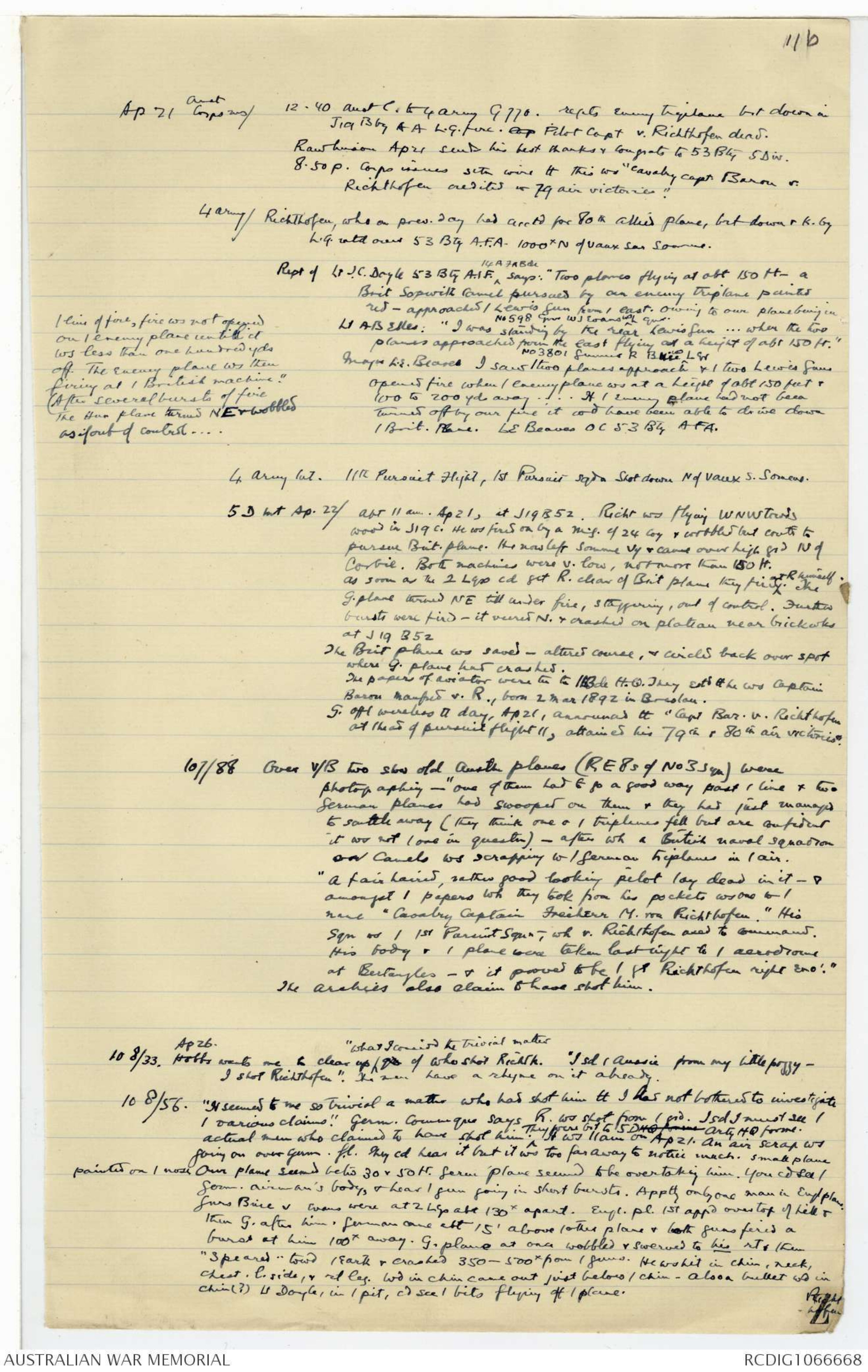
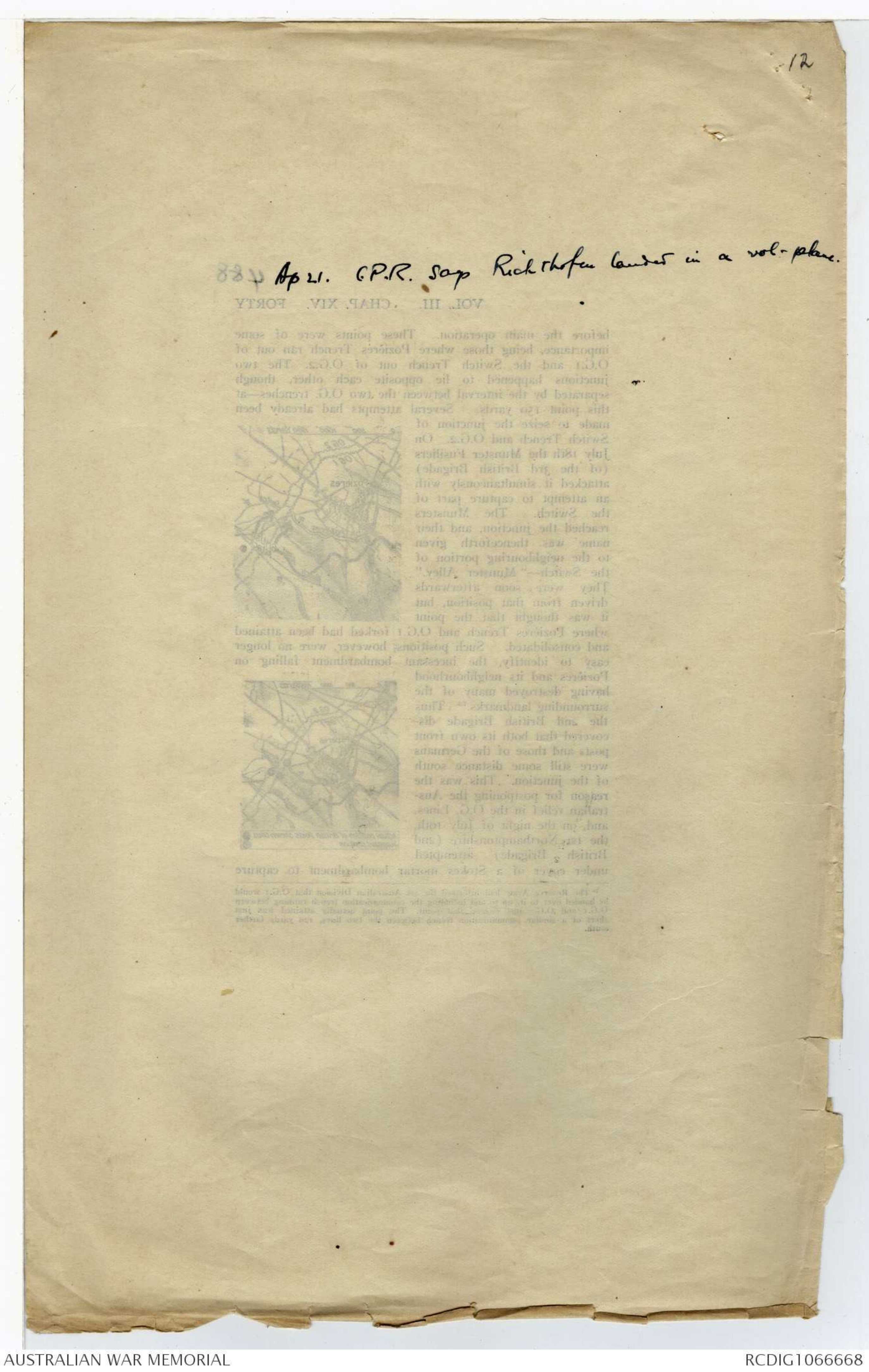

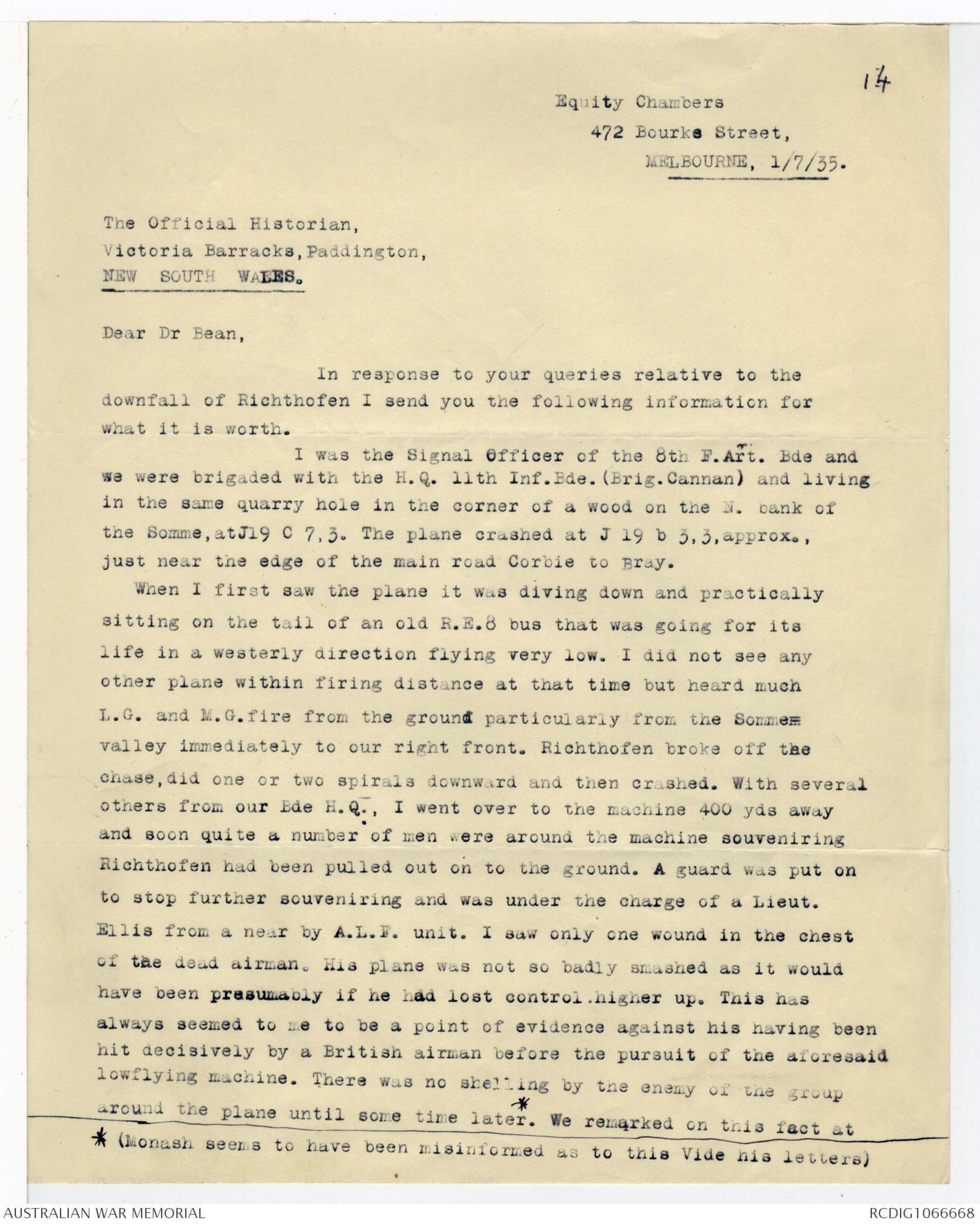
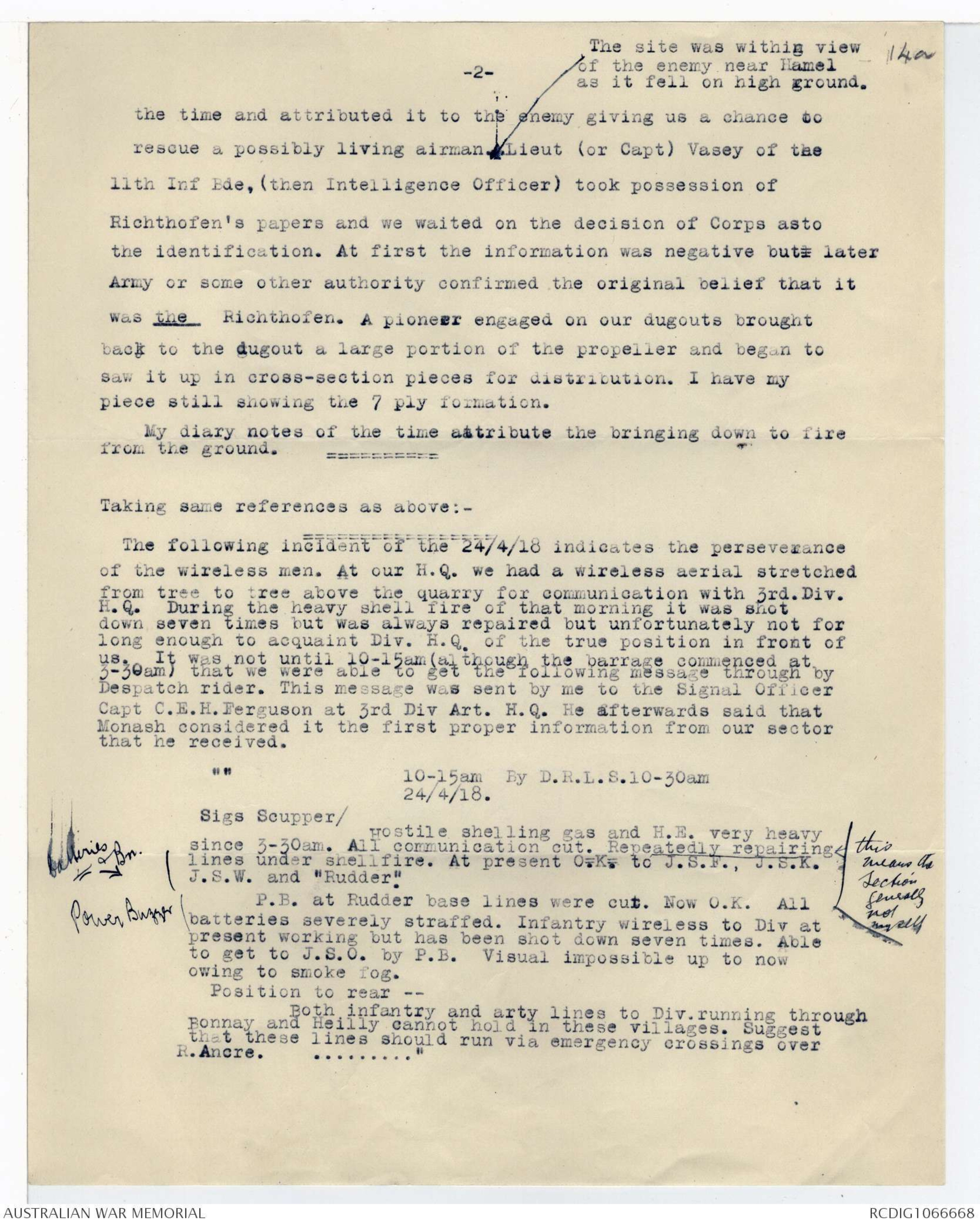
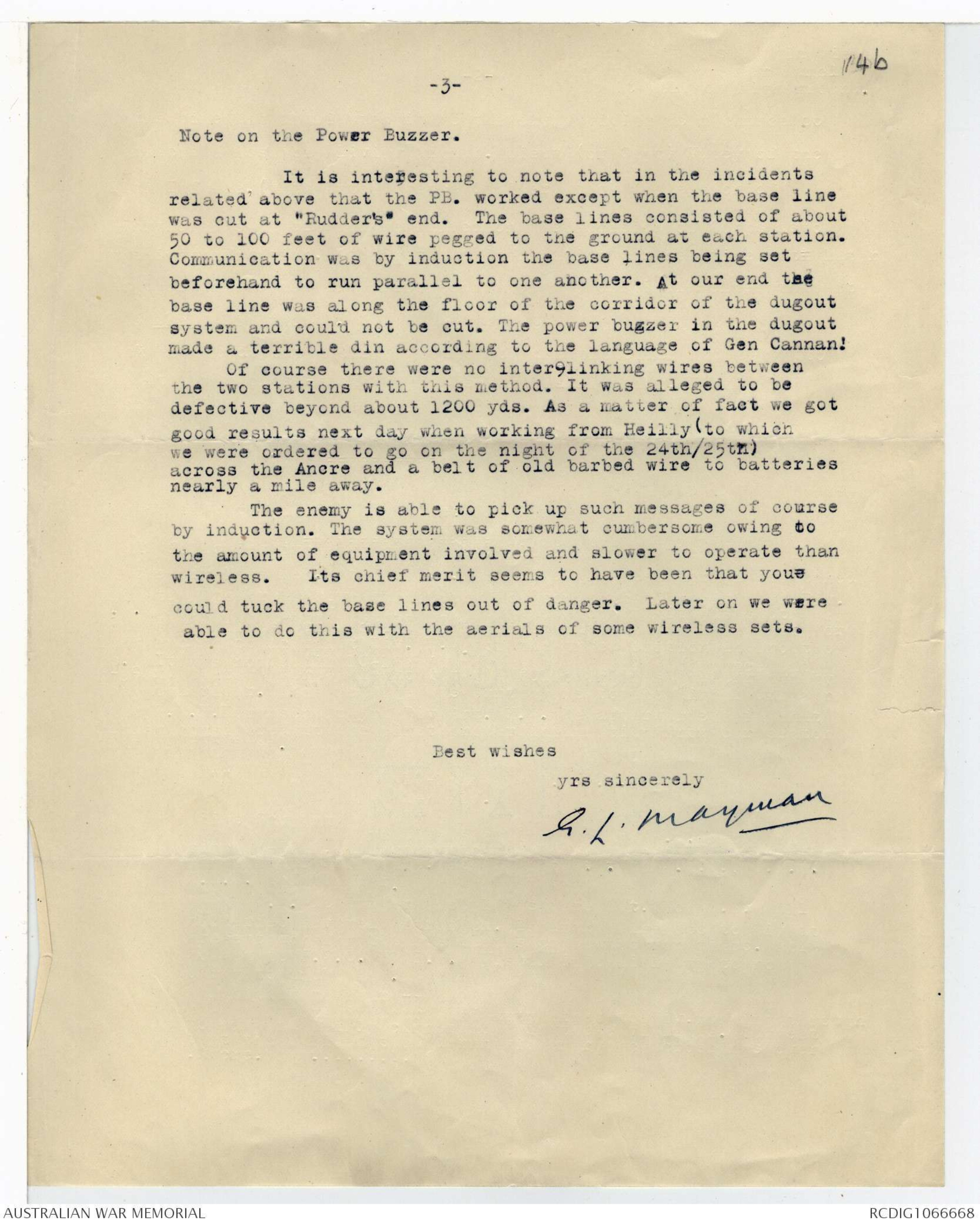
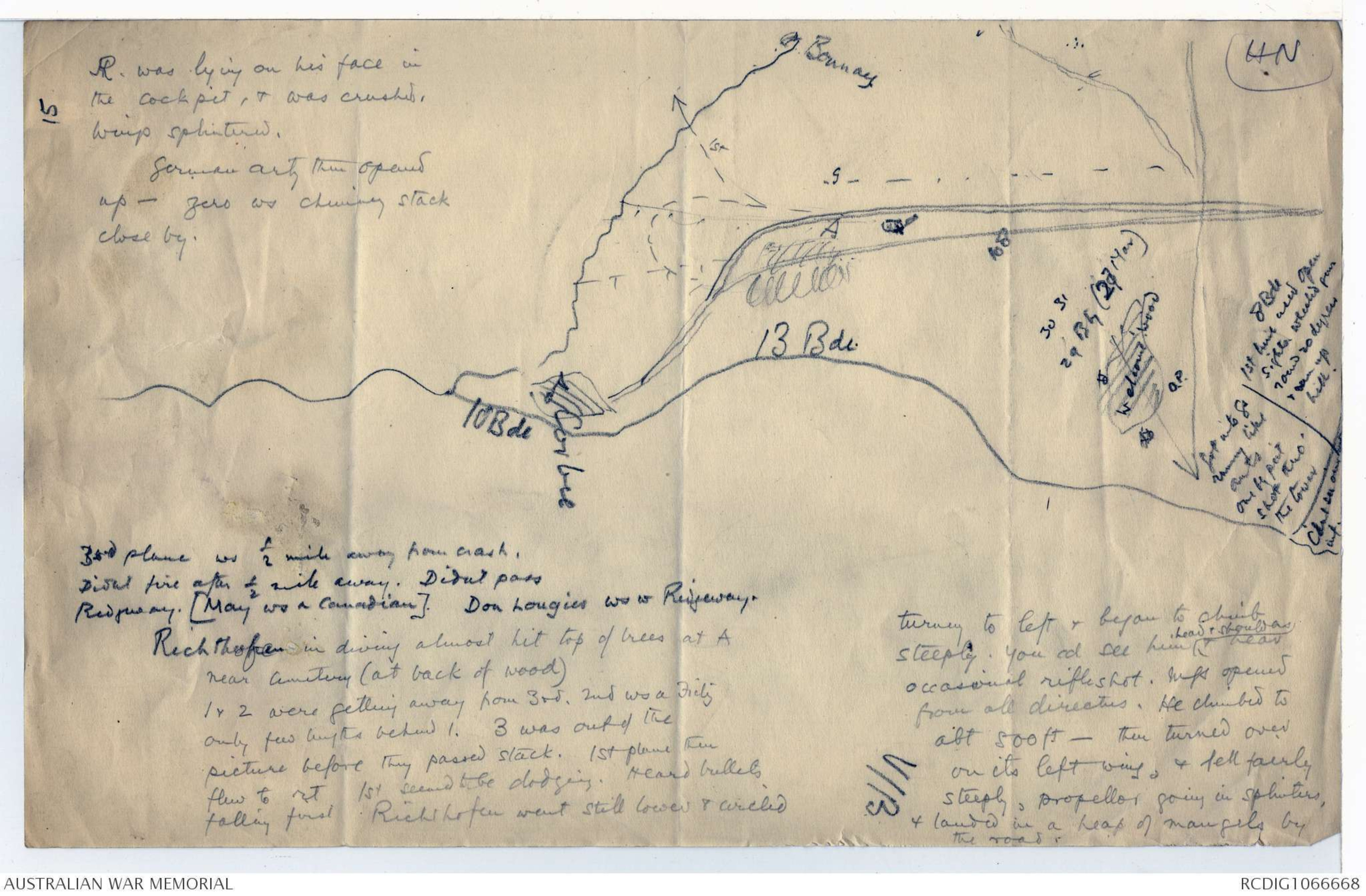
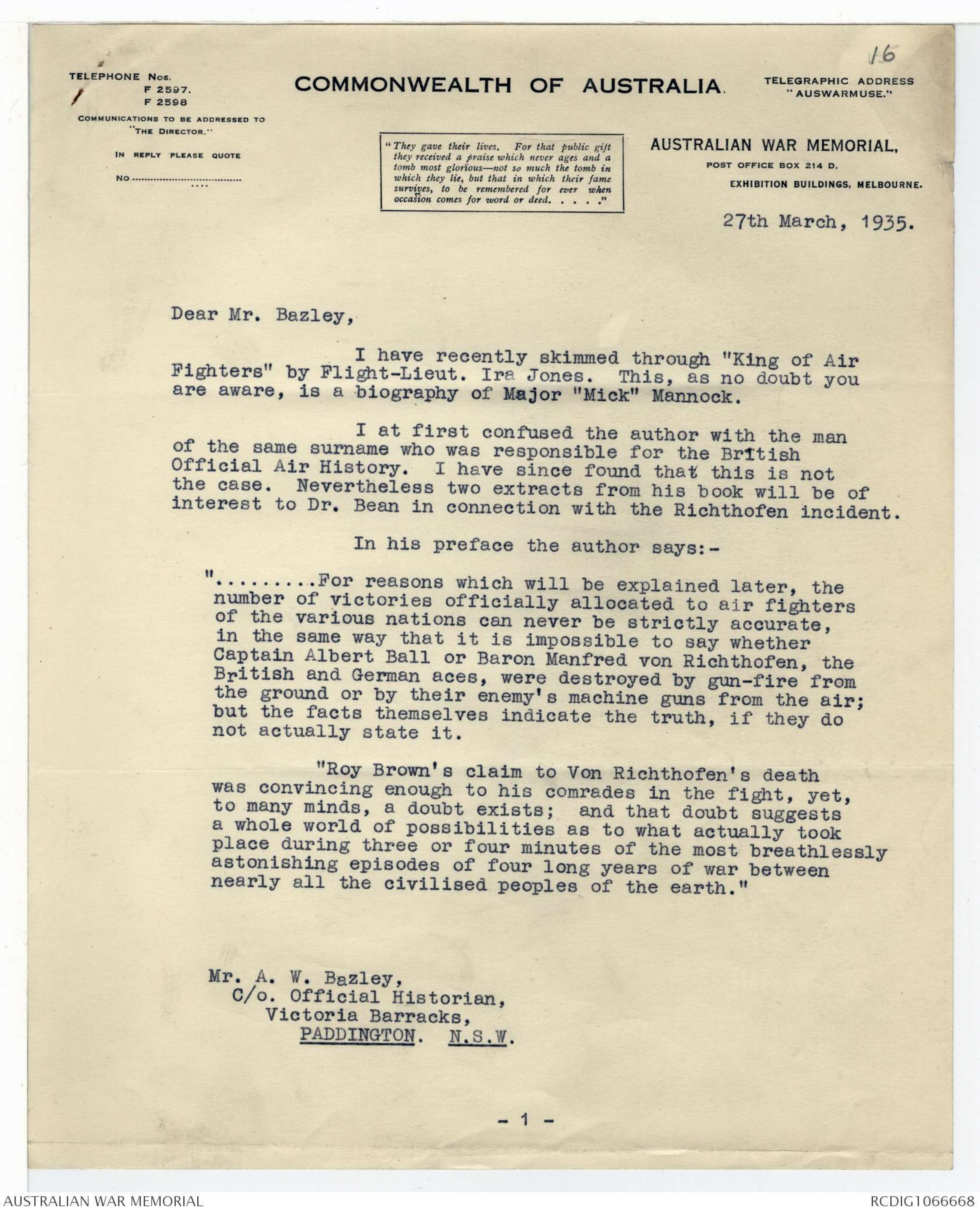
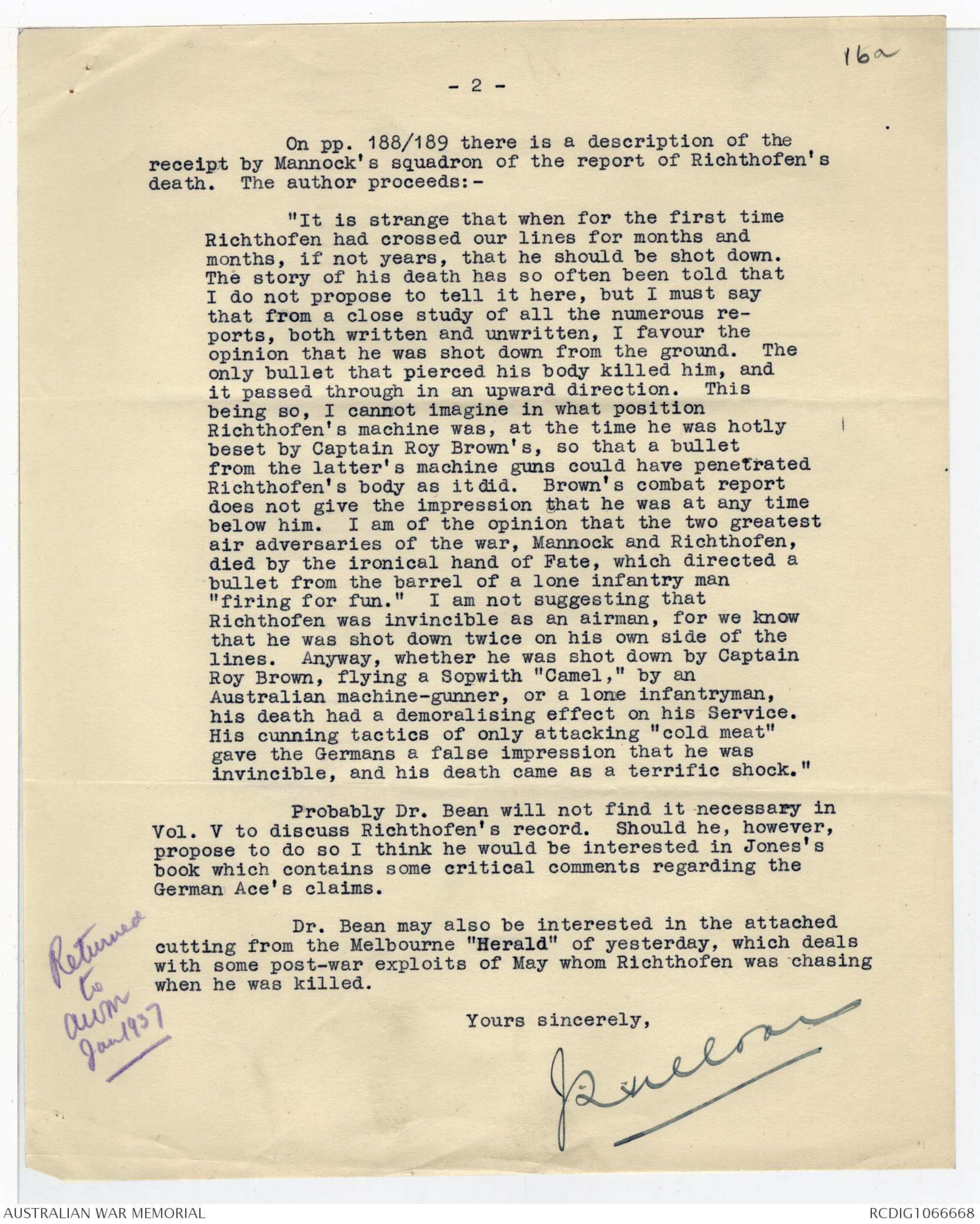
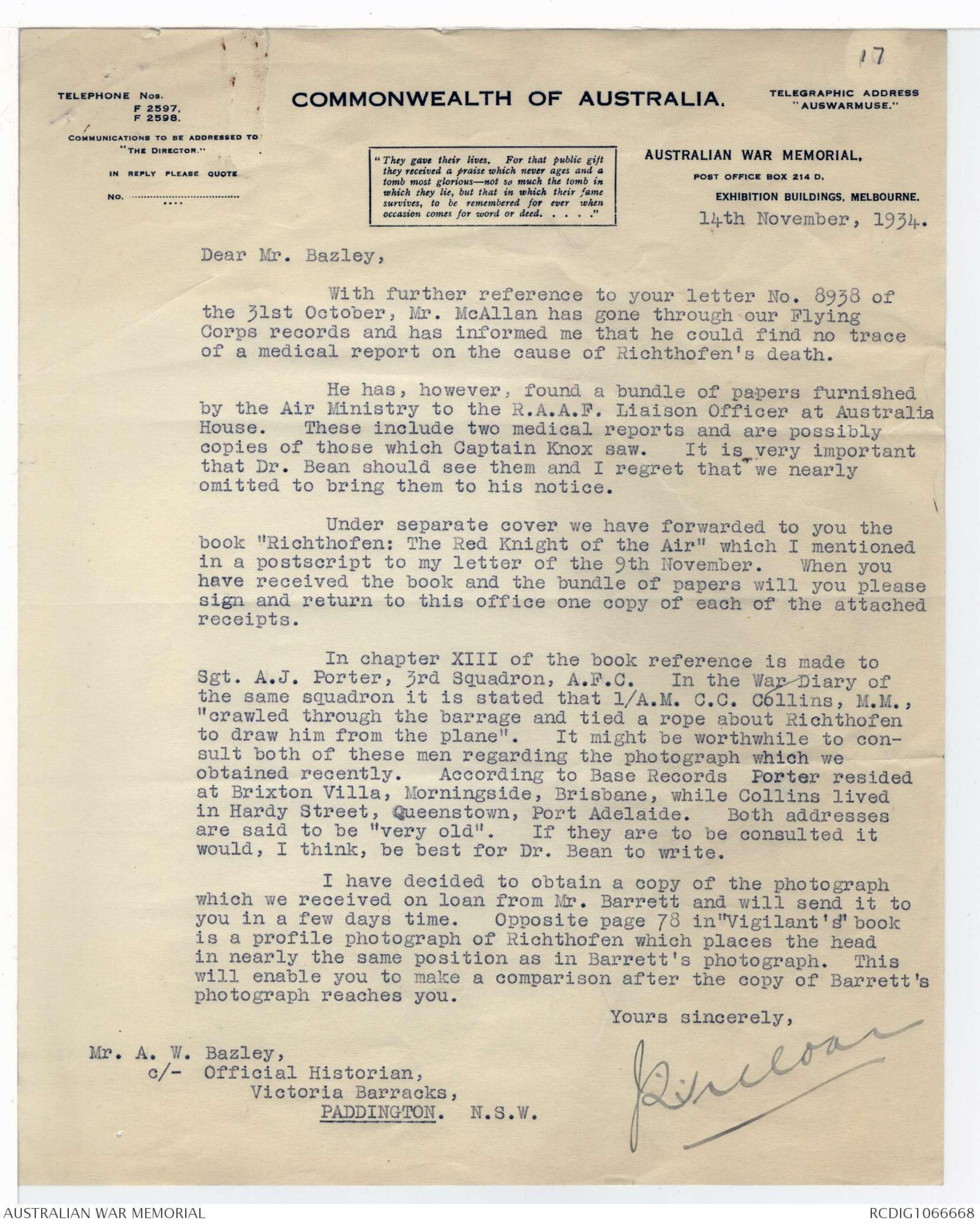
[11b]
Ap 21 Aust Corps ms/
12.40 Aust C. to 4 army G770. repels enemy triplane but down in
Jia B by AA L.G. fire. cap Pilot Capt v Richthofen dead.
Rawlinson Ap 21 sent his best thanks & congrats to 53 Btn 5Div.
8.50 p. Corps issues sitn wire tt this ws "cavalry Capt Baron v.
Richthofen credited w 79 air victories".
4 army/ Richthofen, who on prev. day had acctd for 80th allied plane, brt down & k. by
L.G. [[ratd?]] over 53 Bty A.F.A 1000 x N of Vaux Sur Somme.
Rept of Lt J.C. Dyle 53 Bty A.I.F [[^14A 7n Bde^?]] says: "Two planes flying at abt 150 ft - a
Brit Sopwith Camel pursued by an enemy triplane painted
red - approached / Lewis gun from / east. Owing to our plan being in
No 598 [[?]]
Lt AB Elles: "I was standing by the rear Lewis gun ... when the two
planes approached from the east flying at a height of abt 150 ft."
No 3801 gunner R [[Blue ^w L Gun?]]
Major L.E. Beare I saw / two planes approach & / two Lewis guns
opened fire when / enemy plane was at a height of abt 15 feet &
100 to 200 yds away ... If / enemy plane had not been
turned off by our fire it cd have been able to drive down
1 Brit. Plane. LE Beaves OC 53 Btn AFA.
[* / line of fire, fire was not opened
on / enemy plane until it
ws less than one hundred yds
off. The enemy plan ws then
firing at / British machine."
(After several bursts of fire
the Hun plane turned NE & wobbled
as if our of control ...*]
4 Army Int. 11th Pursuit Flight, 1st Pursuit sqdn shot down N of Vaux S. Somme.
5 D Int Ap. 22/ Abt 11am. Ap 21, at J19B52. Richt was flying WNW twds
wood in J19C. He was fired on by a [[Mig?]] of 24 Coy & wobbled but contd to
pursue Brit. plane. It now left Somme Vy & came over high gd N of
Corbie. Both machines were v. low, not more than 150 ft.
as soon as the 2 [[Lqs?]] cd get R. clear of Brit plane they fire ^at R himself. The
G. plane turned NE till under fire, staggering, out of control. Further
bursts were fired - it veered N. & crashed on plateau near brickworks
at J19 B52.
The Brit plane ws saved - altered course, & circled back over spot
where G. plane had crashed.
The papers of aviator were tn to Bde H.Q. They estd tt he was Captain
Baron Manfred v. R., born 2 Mar 1892 in Breslau.
G. offl wireless tt day, Ap 21, announced tt "Capt Bar. V. Richthofen
at the end of pursuit flight 11, attained his 79th & 80th air victories"
107/88 Over V/B two slow old Austen planes (RE8s of No 3sqn) were
photographing - "one of them had to go a good way past / line & two
German planes had swooped on them & they had just managed
to scuttle away (they think one a / triplane fell but are confident
it was not / one in question) - after wh a British naval squadron
and Camels ws scrapping w / german triplanes in / air.
"a fair haired, rather good looking pilot lay dead in it - &
amongst / papers wh they took from his pockes was one to /
name "Cavalry Captain Freiherr M. von Richthofen." His
sqn ws / 1st Pursuit Squn - wh v. Richthofen used to command.
His body & / plane were taken last night to / aerodrome
at [[Bertayles?]] - & it proved to be / gt Richthofen right eno'."
The [[archies?]] also claim to have shot him.
10 8/33 Ap 26. Hobbs wants me to clear up ^"what I considered the trivial matter^ of who shot Richth. "I sd / Aussie from my little Pozzy -
I shot Richthofen." The men have a rhyme on it already.
10 8/56. "It seemed to me so trivial a matter who had shot him tt I had not bothered to investigate
/ various claims." German communique says R. was shot from / grd. I sd I must see / actual men who claimed to have shot him. ^They were bt to 5 D HQ Bsons Arty HQ for me^ It was 11am on Ap21. An air scrp ws
going on over Germ. fl. They cd hear it but it was too far away to notice much. small plane
painted on / nose. Our plane seemed betwn 30 & 50 ft Germ plane seemed to be overtaking him. You cd see /
Germ airman's body, & hear / gun going in short bursts. Apptly only one man in Engl plane.
Guns [[?]] & Evans were at 2 [[Lgs]] abt 130x apart. Engl. pl. 1st appd over top of hill &
then G. after him. German came abt 15' above / other plane & both guns fired a
burst at him 100x away. G. plane at once wobbled & swerved to his rt & then
"speared" towd / Earth & crashed 350-500x from / guns. He was shot in chin, neck,
check, l. side, & rt leg. Wd in chin came out just below / chin - also a bullet wd in
chin (?) Lt Doyle, in / pit, cd see / bits flying off / plane.
12
Ap 21. CP.R. Sap Richthofen landed in a vol-plane.
WEII
13
RICHTHOFEN
while with the 52nd Battalion was in the line
near Vaux Sur Somme, it was my duty as Scout Corporal
to maintain an observation post on the high ground
to the rear of the village. When not on duty, the
section occupied a cellar in the village under a
semi-ruined house. One day (I did not keep the date),
my companions and I were startled to hear a plane
flying so low that it seemed almost on the roof. We
rushed out in the road in time to see a plane flying
very low and skim over the houses, followed by a
red three-decker German Plane. The German fired a
short burst, while overhead, apparently without affect.
The Britisher soon disappeared over the brow of the
hill in a South Westerly direction and was quickly out
of sight. The German plane did not go beyond the
crest of the hill and turned for his own line. The
plane, which was plainly visible to us, was seen sudden-
ly to rise vertically in the air and then crash on its
nose. I should say that the plane came down about a
mile from where I was standing. We heard afterwards,
that Richthofen, on his return, flew directly over a
Lewis Gun Anti Aircraft battery attached to some
Australian artillery, and that the Aviator had been shot
upwards through the stomach.
Richthofen was certainly not brought down by the
man he was chasing, whose one idea was to get away from
his relentless opponent as quickly as he could. They
say his guns were jammed.
Richthofen owed his death solely to his impetuos-
ity in chasing the Britisher down to ground on his own
side of the line.
While admitting that Richthofen was unlucky, nob-
ody at the time but rejoiced that such a dangerous foe
was at last brought down.
JS Maclane
1935
14
Equity Chambers
472 Bourke Street,
MELBOURNE, 1/7/35.
The Official Historian,
Victoria Barracks, Paddington,
NEW SOUTH WALES.
Dear Dr Bean,
In response to your queries relative to the
downfall of Richthofen I send you the following information for
what it is worth.
I was the Signal Officer of the 8th F. Art. Bde and
we were brigaded with the H. Q. 11th Inf.Bde. (Brig.Cannan) and living
in the same quarry hole in the corner of a wood on the N. bank of
the Somme, at J19 C 7,3. The plane crashed at J 19 b 3.3, approx.,
just near the edge of the main road Corbie to Bray.
When I first saw the plane it was diving down and practically
sitting on the tail of an old R.E.8 bus that was going for its
life in a westerly direction flying very low. I did not see any
other plane within firing distance at that time but heard much
L.G. and M.G. fire from the ground particularly from the Somme
valley immediately to our right front. Richthofen broke off the
chase, did one or two spirals downward and then crashed. With several
others from our Bde H.Q., I went over to the machine 400 yds away
and soon quite a number of men were around the machine souveniring
Richthofen had been pulled out on to the ground. A guard was put on
to stop further souveniring and was under the charge of a Lieut.
Ellis from a near by A.L. F. unit. I saw only one wound in the chest
of the dead airman. His plane was not so badly smashed as it would
have been presumably if he had lost control higher up. This has
always seemed to me to be a point of evidence against his having been
hit decisively by a British airman before the pursuit of the aforesaid
lowflying machine. There was no shelling by the enemy of the group
around the plane until some time later. We remarked on this fact at
*(Monash seems to have been misinformed as to this Vide his Letters)
-2-
14or
the time and attributed it to the enemy giving us a chance to
rescue a possibly living airman Lieut (or Capt) Vasey of the
[*The site was within view
of the enemy near Hamel
as it fell on high ground.*]
11th Inf Bde, (then Intelligence Officer) took possession of
Richthofen’s papers and we waited on the decision of Corps as to
the identification. At first the information was negative butz later
Army or some other authority confirmed the original belief that it
was the Richthofen. A pioneer engaged on our dugouts brought
back to the dugout a large portion of the propeller and began to
saw it up in cross-section pieces for distribution. I have my
piece still showing the 7 ply formation.
My diary notes of the time attribute the bringing down to fire
from the ground.
---------
Taking same references as above:-
---------
The following incident of the 24/4/18 indicates the perseverance
of the wireless men. At our H.Q. we had a wireless aerial stretched
from tree to tree above the quarry for communication with 3rd. Div.
H.Q. During the heavy shell fire of that morning it was shot
down seven times but was always repaired but unfortunately not for
long enough to acquaint Div. H.Q. of the true position in front of
us. It was not until 10-15am (although the barrage commenced at
3-30am) that we were able to get the following message through by
Despatch rider. This message was sent by me to the Signal Officer
Capt C.E.H. Ferguson at 3rd Div Art. H.Q. He afterwards said that
Monash considered it the first proper information from our sector
that he received.
""
10-15am By D.R.L. S. 10-30am
24/4/18.
Sigs Scupper/
Hostile shelling gas and H.E. very heavy
since 3-30am. All communication cut. Repeatedly repairing
[*this means the section generally not myself*]
lines under shellfire. At present O.K. to J.S.F., J.S.K.,
J.S.W. and Rudder!
[*Batteries & Bn*]
P.B. at Rudder base lines were cut. Now O.K. All
[*Power Buzzer*]
batteries severely straffed. Infantry wireless to Div at
present working but has been shot down seven times. Able
to get to J.S.O. by P.B. Visual impossible up to now
owing to Smoke Fog.
Position to rear --
Both infantry and arty lines to Div. running through
Bonnay and Heilly cannot hold in these villages. Suggest
that these lines should run via emergency crossings over
R. Anore ......."
14b
-3-
Note on the Power Buzzer.
It is interesting to note that in the incidents
related above that the PE. worked except when the base line
was cut at "Rudder's" end. The base lines consisted of about
50 to 100 feet of wire pegged to the ground at each station.
Communication was by induction the base lines being set
beforehand to run parallel to one another. At our end the
base line was along the floor of the corridor of the dugout
system and could not be cut. The power buzzer in the dugout
made a terrible din according to the language of Gen Cannan!
Of course there were no inter-linking wires between
the two stations with this method. It was alleged to be
defective beyond about 1200 yds. As a natter of fact we got
good results next day when working from Heilly (to which
we were ordered to go on the night of the 24th/25th)
across the Ancre and a belt of old barbed wire to batteries
nearly a mile away.
The enemy is able to pick up such messages of course
by induction. The system was somewhat cumbersome owing to
the amount of equipment involved and slower to operate than
wireless. Its chief merit seems to have been that youe
could tuck the base lines out of danger. Later on we were
able to do this with the aerials of some wireless sets.
Best wishes
yrs sincerely
G.L. Mayman
[*15*]
R was lying on his face in
the cockpit, & was crushed,
wings splintered.
German arty then opened
up - zero cas chimney stack
close by.
[*Hand drawn map depicting location of death of Baron Manfred Albrecht von Richthofen. References Corbie, locations:
- 10 Bde and
- 13 Bde,
- Bonnay
- Corbie
- Welcome Wood
- cross
- Lines that may reflect topography (ie hill), and direction of travel (eg arrow)*]
[*8 Bde
1st time used open
sighted wheeled [[guns?]]
[[?]]*]
[*30 31
29 Btn (27 Mar)8]
[*got into [[?]]
one by post
shot two
the tower
-------------
Chart see over*]
[[?]] plane was 1/2 mile away from crash.
Didnt fire after 1/2 mile away. Didn't pass
Ridgeway (May was a Canadian). Don Lougies was to Ridgeway.
Richthofer in diving almost hit top of trees at A
near cemetery (at back of wood)
1 & 2 were getting away from 3rd. 2nd was a [[?]]
only few lengths behind 1. 3 was out of the
picture before they passed stack. 1st plan then
flew to [[?]] 1st seemed to be dodging. Heard bullets
falling first Richthofer went still lower & circled
turning to left & began to climb
steeply. You cd see him ^head & shoulders^ & hear
occasional rifleshot. [[Mgs?]] opened
from all directions. He climbed to
abt 500 ft - there turned over
on its left wing & fell fairly
steeply, propellor going in splinters,
& landed in a heap of [[mangels?]] by
the road.
[*V/B*]
16
Telephone Nos.
F 2597
F 2598
COMMUNICATIONS TO BE ADDRESSED TO
"THE DIRECTOR"
IN REPLY PLEASE QUOTE
NO ........................................
COMMONWEALTH OF AUSTRALIA
"They gave their lives. For that public gift
they received a praise which never ages and a
tomb most glorious - not so much the tomb in
which they lie, but that in which their fame
survives, to be remembered for ever when
occasion comes for word or deed ...."
TELEGRAPHIC ADDRESS
"AUSWARMUSE."
AUSTRALIAN WAR MEMORIAL,
POST OFFICE BOX 214 D,
EXHIBITION BUILDINGS, MELBOURNE.
27th March 1935
Dear Mr. Bazley,
I have recently skimmed through "King of Air
Fighters" by Flight-Lieut. Ire Jones. This, as no doubt you
are aware, is a biography of Major "Mick" Mannock.
I at first confused the author with the man of the same surname who was responsible for the British Official
Official Air History. I have since found that this is not
the case. Nevertheless two extracts from his book will be of
interest to Dr. Bean in connection with the Richthofen incident.
In his preface the author says:-
".......For reasons which will be explained later, the
number of victories officially allocated to air fighters
of the various nations can never be strictly accurate,
in the same way that it is impossible to say whether
Captain Albert Ball or Baron Manfred von Richthofen, the
British and German aces, were destroyed by gun-fire from
the ground or by their enemy's machine guns from the air;
but the facts themselves indicate the truth, if they do
not actually state it.
"Roy Brown's claim to Von Richthofen's death
was convincing enough to his comrades in the right, yet,
to many minds, a doubt exists; and that doubt suggests
a whole word of possibilities as to what actually took
place during three or four minutes of the most breathlessly
astonishing episodes of four long years of war between
nearly all the civilised peoples of the earth."
Mr. A.W. Bazley,
C/o. Official Historian,
Victoria Barracks,
PADDINGTON. N.S.W.
16a
-2-
On pp. 188/189 there is a description of the
receipt by Mannock's squadron of the report of Richthofen’s
death. The author proceeds:-
"It is strange that when for the first time
Richthofen had crossed our lines for months and
months, if not years, that he should be shot down.
The story of his death has so often been told that
I do not propose to tell it here, but I must say
that from a close study of all the numerous re-
ports, both written and unwritten, I favour the
opinion that he was shot down from the ground. The
only bullet that pierced his body killed him, and
it passed through in an upward direction. This
being so, I cannot imagine in what position
Richthofen’s machine was, at the time he was hotly
beset by Captain Roy Brown’s, so that a bullet
from the latter’s machine guns could have penetrated
Richthofen’s body as it did. Brown’s combat report
does not give the impression that he was at any time
below him. I am of the opinion that the two greatest
air adversaries of the war, Mannock and Richthofen,
died by the ironical hand of Fate, which directed a
bullet from the barrel of a lone infantry man
"firing for fun." I am not suggesting that
Richthofen was invincible as an airman, for we know
that he was shot down twice on his own side of the
lines. Anyway, whether he was shot down by Captain
Roy Brown, flying a Sopwith "Camel," by an
Australian machine-gunner, or a lone infantryman,
his death had a demoralising effect on his Service.
His cunning tactics of only attacking "cold meat"
gave the Germans a false impression that he was
invincible, and his death came as a terrific shock."
Probably Dr. Bean will not find it necessary in
Vol. V to discuss Richthofen’s record. Should he, however
propose to do so I think he would be interested in Jones’s
book which contains some critical comments regarding the
German Ace's claims.
Dr. Bean may also be interested in the attached
cutting from the Melbourne "Herald" of yesterday, which deals
with some post-war exploits of May whom Richthofen was chasing
when he was killed.
Yours sincerely,
[[?]]
[*Returned to AWM Jan 1937*]
[*17*]
Telephone Nos.
F 2597
F 2598
COMMUNICATIONS TO BE ADDRESSED TO
"THE DIRECTOR"
IN REPLY PLEASE QUOTE
NO ........................................
COMMONWEALTH OF AUSTRALIA
"They gave their lives. For that public gift
they received a praise which never ages and a
tomb most glorious - not so much the tomb in
which they lie, but that in which their fame
survives, to be remembered for ever when
occasion comes for word or deed ...."
TELEGRAPHIC ADDRESS
"AUSWARMUSE."
AUSTRALIAN WAR MEMORIAL,
POST OFFICE BOX 214 D,
EXHIBITION BUILDINGS, MELBOURNE.
14th November 1934
Dear Mr. Bazley,
With further reference to your letter No. 8938 of
the 31st October, Mr McAllan has gone through our Flying
Corps records and has informed me that he could find no trace
of a medical report on the cause of Richthofen's death.
He has, however, found a bundle of papers furnished
by the Air Ministry to the R.A.A.F. Liaison Officer at Australia
House. These include two medical reports and are possibly
copies of those which Captain Knox saw. It is very important
that Dr. Bean should see them and and I regret that we nearly
omitted to bring them to his notice.
Under separate cover we have forwarded to you the
book "Richthofen: The Red Knight of the Air" which I mentioned
in a postscript to my letter of the 9th November. When you
have received the book and the bundle of papers will you please sign and return to this office one copy of each of the attached
receipts.
In chapter XIII of the book reference is made to
Sgt. A.J. Porter, 3rd Squadron, A.F.C. In the War Diary of
the same squadron it is stated that 1/A.M. C.C. Collins, M.M.,
"crawled through the barraged and tied a rope about Richthofen
to draw him from the plan". It might be worthwhile to con-
sult both of these men regarding the photograph which we
obtained recently. According to Base Records Porter resided
at Brixton Villa, Morningside, Brisbane while Collins lived
in Hardy Street, Queenstown, Port Adelaide. Both addresses
are said to be "very old". If they are to be consulted it
would, I think, be best for Dr Bean to write.
I have decided to obtain a copy of the photograph
which we received on loan from Mr. Barrett and will send it to
you in a few days time. Opposite page 78 in "Vigilant's" book
is a profile photograph of Richthofen which placed the head
in nearly the same position as in Barrett's photograph. This
will enable you to make a comparison after the copy of Barrett's photograph reaches you.
Yours sincerely,
[[?]]
Mr. A.W. Bazley,
C/o. Official Historian,
Victoria Barracks,
PADDINGTON. N.S.W.
 Sam scott
Sam scottThis transcription item is now locked to you for editing. To release the lock either Save your changes or Cancel.
This lock will be automatically released after 60 minutes of inactivity.